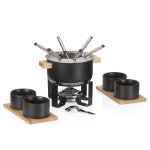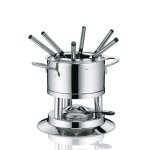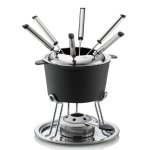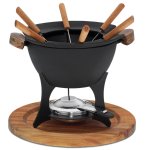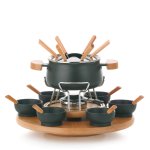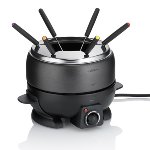- Bath
- Kitchen
- Collections
- Contact
- Company
- Catalogues

Fondue - appliances, sets & recipes
From classic fondue, fondue sets, and fondue carousels, to fondue recipes.
-
Fondue set Gunten 16 piecesItem No.: 10068
-
Fondue-set Cailin 10 piecesItem No.: 10968
-
Fondue-set Calido 10 piecesItem No.: 16620
-
Cheese fondue-pan CalidoItem No.: 16622
-
Fondue-set Comore 11 pcsItem No.: 16639
-
Fondue-set 11 piecesItem No.: 16644
-
-
Buying a fondue - cooking with friends
Winter is fondue season, whether it's for a cosy festive meal on Christmas Eve and New Year's Eve or a cold winter evening with friends or family. The relaxed social aspect is the highlight of fondue dining. The host can calmly prepare the ingredients and doesn’t have to spend hours in the kitchen before the meal. When it comes to cooking and enjoying the meal, the host is comfortably seated at the table, not rushing back and forth between the kitchen and guests. There's no rush or time pressure with this kind of meal. Instead, it's a chance to catch up with friends and family, chat about the past few weeks, holidays, and maybe even make plans for the future.
Thinking of buying a fondue set? We’d like to help you make a decision with the following information. Fondue appliances generally have the same basic structure. You might want to consider whether you’d prefer a fondue set or a fondue carousel. This could depend on kitchen space or your preference for a more refined presentation. Perhaps the material or appearance is important to you. Finding and buying the right fondue set for you is easier than you might think – just explore our range.
Fondue sets and fondue carousels
One of the first choices is the size of the fondue set. A typical fondue set consists of the fondue pot, a rechaud, a safety fuel burner (without fuel paste), a tray/plate, and several fondue forks. Fondue sets are more compact, taking up less space in both the cupboard and on the table.
A fondue carousel, on the other hand, also includes small bowls for dips and sauces arranged on a rotating tray. This tray can turn in both directions while the fondue pot remains stationary, allowing each guest to easily access their desired ingredient. A fondue carousel adds a professional touch to the table, making it look neatly arranged, with everything within easy reach for everyone.
Fondue sets and carousels are typically designed for up to six people, determined by the six accompanying fondue forks and the slots for the forks in the splash guard. Fondue pots are often made of stainless steel, cast iron, or enamelled metal, which are durable materials capable of withstanding high temperatures.
Regardless of which option you choose – a fondue set or a carousel – your next fondue evening will surely be a success.

Is a fondue pot suitable for induction?
In the fondue range, there are now several fondue pots that are suitable for induction. These pots need a ferromagnetic base, which cast iron pots, like the Country Fondue Set, provide. Stainless steel and enamelled metal pots may also be suitable for induction hobs, depending on how they're made. If you have an induction hob, you should choose a fondue pot designed for induction cooking. As the oil or broth is usually heated on the hob before being transferred to the fondue pot, a suitable pot is a great advantage.
Each of our fondue sets includes information about which types of hobs they are compatible with. The included user manuals, which are also available for download, provide further details. Whether a fondue pot is suitable for induction cooking can be identified on the packaging by the induction symbol, known as the coil symbol.

Electric fondue
For those open to new ideas, an electric fondue set might be the perfect addition to your kitchen. Electric fondue sets are heated from below, just like traditional fondue, but via an electric heating plate. The temperature can be continuously adjusted, making it suitable for various types of fondue and cooking styles. While chocolate fondue requires very low heat, broth fondue needs much higher temperatures.
Electric fondue sets are ready to use immediately, removing the need to buy fuel paste, and they offer a much lower fire risk than open flames. If children are involved in the fondue meal, this safety aspect is especially important.
Although electric fondue sets offer many advantages, it's fair to say that the traditional fondue atmosphere might be somewhat diminished. However, for those seeking a versatile addition to their kitchen, the Simplon Electric Fondue Set for six people is an excellent choice.
Fondue ingredients – varied preparation options: oil or broth?
A common question is: oil or broth? The most popular choice is oil fondue, known as Fondue Bourguignonne. Broth fondue, which originated in Asia, is also becoming increasingly popular. What are the differences? For one, both oil and broth impart their own flavour to the meat, and the cooking results also differ between the two methods. Additionally, broth is lower in fat and might be easier to digest. Generally, it’s best to choose neutral-tasting oils like sunflower or rapeseed oil that can withstand high temperatures. Cooking fondue with coconut oil is also worth trying for a richer flavour. Meat cooked in oil or fat tends to be more flavourful and crispy, while meat in broth is gently poached. Since broth doesn't get as hot as oil, it's a good idea to prepare the meat pieces smaller for this method.
Fondue ingredients for meat fondue
A wide variety of meats can be used for meat fondue:
- Pork
- Chicken
- Chicken
- Lamb
The key is a short cooking time. For oil fondue, the meat should be leaner than for the broth version. As for portion sizes, the rule of thumb is around 200–300 grams per person, depending on the number of sides being served.
Fondue ingredients for fish fondue
If you're looking to offer something different from the classic meat fondue, a fish fondue is a fantastic idea. Suitable fish varieties include those with firm flesh that won’t fall apart while cooking.
- Salmon
- Monkfish
- Tuna
- Prawns
- Scallops
Again, the cooking time is short, ensuring that the fish fondue turns out perfectly. The portion sizes are similar to meat fondue – about 200–300 grams per person.
Vegan or vegetarian fondue
For health-conscious diners, vegetarians, or vegans, a vegetable fondue is the ideal choice. A wide variety of vegetables can be used to make it colourful and diverse
- Broccoli
- Kohlrabi
- Aubergines
- Carotts
- Courgettes
- Peppers
These vegetables can be cooked in either broth or oil. Why not try dipping some of them in batter before frying? It’s worth experimenting!
Don't forget – essential sides for a perfect fondue
Guests will love grabbing baguettes and fresh salads that are within easy reach on the table. And no fondue is complete without dips and sauces, served in small bowls. What sauces typically go with fondue? A classic garlic sauce is a must, along with favourites like guacamole, tomato salsa, and even more exotic options like pineapple-chilli or apple-ginger sauce.
Fondue recipes - dips and sauces that always work
These sauces are quick to make and go well with meat, fish and vegetables.
Garlic sauce with apple
8 tbsp mayonnaise
2 cloves of garlic
Salt, mixed pepper
1 apple
Lemon juice
Parsley, chopped
Peel and grate the apple, and drizzle it with a little lemon juice. Mix all the ingredients together. Let it sit briefly before serving. Stir again and sprinkle with chopped parsley before serving.
Guacamole
2 avocados
1 small red pepper
4 - 5 small cherry tomatoes
1 clove of garlic
Lemon juice
Salt, pepper, chilli to taste
Puree the avocados with a mixer or mash with a fork. Add lemon juice. Finely chop the pepper, tomatoes, and garlic. Mix all the ingredients and season with salt and pepper.
Pineapple-chilli sauce
1 baby pineapple or approx. 300 - 500 g fruit
1 chilli pepper
3 tbsp olive oil
3 tbsp white balsamic vinegar
a pinch of salt
100 g sugar
Sauté the pineapple and finely chopped chilli in olive oil. Add the remaining ingredients and simmer until reduced
Fondue pots with different capacities
When buying a fondue set, you might want to consider the size of the pot. This could depend on the size of your family or how often you host guests. Small pots have a capacity of 0.6–0.8 litres, the standard volume is around 1 litre, and electric fondue sets can hold up to 1.7 litres. This refers to the capacity for broth or oil. The diameter of the pots ranges from Ø 16 cm to around Ø 27 cm.
Fondue pots with 0.6 - 1.0 litre capacity
Fondue pots with a relatively small volume are ideal for couples and small families. The Comore fondue set is one of the smallest in our range. It’s a classically elegant fondue set featuring a cast iron pot, which is also suitable for induction. Other components of this 11-piece set include: a stand (rechaud), safety fuel burner, splash guard, underplate, and six fondue forks.
Fondue pots with 1.2 - 1.7 litre capacity
While most of our models have a capacity between 1.0 and 1.2 litres, the electric fondue set Simplon, with a 1.7-litre volume for broth or oil, is our largest fondue set. Fondue carousels, despite their larger external dimensions, generally have standard-sized fondue pots of 1.0 to 1.2 litres. This size is perfect for families or for a lovely evening with up to six people.
Fondue pots made from various materials
Most fondue pots for broth or oil-based fondues are made from stainless steel, cast iron, or metal. For cheese fondues, however, ceramic pots are the best choice. The type of pot you need depends on what you’ll be heating inside. For broth and oil fondues, metal, including stainless steel, and cast iron pots are excellent, as they conduct heat quickly. The following materials are all well-suited for fondue preparation, with the final choice often coming down to aesthetics.
Since oil-based fondues pose a higher risk of splattering, fondue pots designed for this purpose have smaller openings and come with a matching splash guard. Additionally, pots for meat, fish, and vegetables tend to be deeper, with a spherical or cylindrical shape.
Stainless steel fondue pots
Stainless steel fondue pots have a naturally sleek and elegant look. Stainless steel is durable and easy to care for. As it’s a metal, these pots are relatively lightweight, similar to enameled metal pots. Stainless steel is ideal for both broth and oil fondues, thanks to its excellent heat conductivity and heat retention. The Cailin fondue set brings understated elegance to the table.
Cast iron fondue pots
Cast iron fondue pots are significantly heavier than metal ones. Aesthetically, these pots complement fondues well, whether for broth or oil. Cast iron pots offer superb heat distribution and retain warmth for a long time. Cast iron is robust and gives off a natural, rustic feel. These models are also suitable for induction cooking.
Enamelled metal fondue pots
Enameled metal fondue pots, similar to stainless steel pots, are durable and easy to care for. The enamel coating not only protects the pots from rust but also allows for a wide range of design possibilities. This includes various colours or matte and glossy finishes. Due to their excellent heat conductivity and retention, these pots are a great choice for oil and broth fondues. The Natura fondue carousel features a matte surface.
Care and use tips for fondue pots
Stainless steel
- To remove stubborn food residues, soak the pot in washing-up water. These can then be easily removed with a dishwashing sponge
- Limescale and water stains can be easily removed with a little vinegar water
Enamelled metal / cast iron
- Allow the pan to cool and soak in warm water
- Do not scratch the pan with sharp metal objects
- Do not use steel wool for cleaning
Fondue accessories: buying the perfect fondue plates
To create a beautifully coordinated fondue evening, the table can be set with special fondue plates. These plates typically have multiple sections, providing plenty of space to arrange sauces, dips, and side dishes. Our classic fondue plates, Anneli and Vroni, come with five sections. Both designs are available in black and white.
In our "Accessories" section, you’ll find a wide range of practical items for fondue and raclette: fondue sieves for ingredients that may fall apart on forks, fondue forks, fuel burner sets, and fuel refills for fondue sets.
Frequently asked questions about fondue
What is fondue?
Fondue traditionally refers to a dish made from melted cheese – the classic cheese fondue. However, oil and broth fondues have also been around for a long time. In oil or broth, small pieces of meat, fish, or vegetables are cooked. Meat fondues, particularly Fondue Bourguignonne, have a long-standing tradition. When the ingredients are cooked in hot broth, it’s an Asian variant, with the best-known example being Fondue Chinoise. In fondue, bite-sized pieces of meat, fish, or vegetables are dipped into the hot oil or broth, then into the accompanying dips and sauces.
What ingredients are used for fondue?
There are many delicious variations of fondue. Whether you prefer meat fondue, cheese fondue, or a vegetarian option, it all comes down to personal taste. For a meat fondue, beef fillet is traditionally used, but lean pork or turkey fillet works just as well. For a fish fondue, fish with firm flesh is ideal. Excellent choices include tuna, salmon fillet, prawns, and scallops. For a vegetarian fondue, broccoli, cauliflower, mushrooms, carrots, fennel, and more can be served.
How much meat or fish should I plan for per person?
To ensure that the pieces of meat, fish, and vegetables cook through properly, they should be cut into small pieces. Planning the right amount of meat or fish can be tricky. Are most of the guests men or women? Are children at the table? Will there be a starter and dessert? As a rough guideline, plan for around 200 - 300 grams of meat or fish per person. For vegetables, you can be more generous.
Can a normal pot be used for fondue?
For meat or fish fondue, stainless steel, enamelled metal, or cast iron pots are excellent choices. Fondue sets come with a suitable stand (rechaud), which keeps the pot heated during the meal. This heat is necessary to keep the oil or broth hot enough for cooking the meat, fish, or vegetable pieces. While a regular pot could be used, it would need to sit on an electric warming plate. Regular pots also don’t come with a splash guard, which is particularly important for oil fondue.
What accessories and spare parts are available for fondue?
A fondue set includes all the key components needed for a successful fondue. To start enjoying your meal straight away, all you’ll need is fuel paste for the burner. As accessories, you can buy special fondue plates, fondue forks, fondue sieves, fuel paste, safety fuel burners, and even additional rechauds, all available in our accessory range.
Can a normal fondue pot be used for chocolate fondue?
For a chocolate fondue, much like a cheese fondue, less heat is required compared to oil or broth fondues. As metal or stainless steel pots conduct and retain heat very well, they aren’t ideal for chocolate fondue, as the chocolate may burn on the bottom. However, a cheese fondue set with a ceramic pot can also be used for chocolate fondue. Chocolate fondues are typically smaller, as they are often served as a dessert and don’t require large quantities. Special chocolate fondues use a tealight to generate and maintain the right amount of heat, which is sufficient for melting the chocolate.




